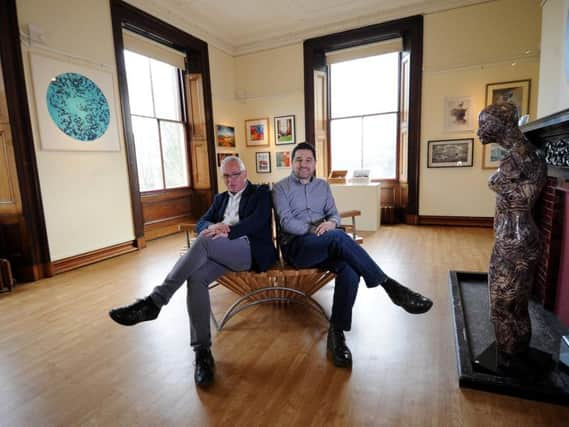How Scarborough community is working to transform the seaside town


“For too long, seaside towns have been neglected. They suffer from issues rooted in the decline of their core industries, most notably domestic tourism, but also in fishing, shipbuilding and port activity - and from their location at the ‘end of the line’.”
These alarming words of Lord Bassam of Brighton, accompanied the publication of a report by the House of Lords Select Committee on the future of seaside towns last month. It concluded that many coastal communities were in desperate need of improvements to transport, housing and broadband and that better access to further and higher education was needed for young people.
Advertisement
Hide AdAdvertisement
Hide AdBut it offered a positive outlook, with Lord Bassam claiming that seaside towns can “once again” become “prosperous and desirable places to live in and visit” with the help of initiatives and interventions on both a local and national scale. Whilst it was Brighton and Bournemouth that he listed as examples of the seaside successfully re-inventing itself, good practice in Scarborough was also highlighted in the report.


Recognition
Ten years ago, the coastal community was named the most enterprising place in Europe by the European Commission, in recognition of work to diversify industry, bring about private investment and encourage people to start-up and grow businesses, and create jobs.
A decade on, that pioneering spirit appears to be alive and well - and it is continuing to drive forward regeneration in Scarborough, according to Tracy Blundell, who works with businesses, schools and colleges to focus on economic development and educational attainment.
“One of the things I got from the Government report is that nobody is going to fix this for those seaside places,” says Tracy, strategic relationship manager at the University of Hull’s North Yorkshire Partnership Hub in Scarborough. “It really is about that entrepreneurial spirit in places like Scarborough, where they recognise they’ve got to do it for themselves - and I can see lots of that happening.”
Advertisement
Hide AdAdvertisement
Hide AdJames Farrar agrees. “If you look at Scarborough over the last ten years, it has made huge progress and shown huge ambition,” the chief operating officer of the York, North Yorkshire and East Riding Local Enterprise Partnership says. “It’s done this by the business community coming together with the public sector.”
“We are getting many attractions and organisations choosing Scarborough as their location,” he adds. “That is a sign people have confidence in the place.”
A decade of transformation
There has indeed been transformation over the past decade, not least to try to equip people with skills to meet the needs of local employers, particularly in the manufacturing, construction, digital and creative industries.
The annual Scarborough Science and Engineering Week, this year marking its tenth anniversary, has been at the core. It was founded in 2010 by the Scarborough Business Ambassadors, driven by a need to promote careers in science, technology, engineering and maths and the local progression routes available, to improve recruitment.
Advertisement
Hide AdAdvertisement
Hide AdOff the back of its success, Scarborough University Technical College, which the Lords committee commended in its report, opened in 2016, with a focus on computer science, cyber technology, and engineering, alongside more traditional subjects. It works with partners including Government intelligence service GCHQ, which has a base on nearby Irton Moor, Flamingo Land, which is planning a new attraction on the town’s seafront, McCain and Sirius Minerals which is developing a polyhalite mine near Whitby.
“One of the problems for regeneration is that sense of a lack of opportunity,” explains Lee Kilgour, college principal. “By working with employers to raise awareness of careers in the area, we deliver the employable skills young people need to take their place in those careers.”
Tourist destination
Tourism still provides employment too and attracts thousands of people to Scarborough each year - statistics from tourism agency Visit Britian show, outside London, it was the most popular destination for holiday trips by British residents between 2015 and 2017.
But James says the town is trying to extend the season, with the help of developments including the Alpamare Water Park, which opened in 2016, and Scarborough Open Air Theatre, which since its reopening after refurbishment in 2010 has hosted acts including Elton John and Status Quo and has Kylie Minogue scheduled to perform in August.
Advertisement
Hide AdAdvertisement
Hide AdOrganisations such as Scarborough Museums Trust (SMT), Woodend creative hub and the Stephen Joseph Theatre (SJT) are also working on a cultural strategy for regeneration, which aims to capitalise on the town’s assets and continue to develop events programmes for residents and visitors alike.
“It’s about enriching the lives of people here first, making it an attractive place to be and in turn that meaning it is an attractive place to visit,” says Paul Robinson, artistic director at SJT.
“I genuinely think there’s this new discovery of the British seaside, that it’s kind of cool again,” adds Simon Hedges, Head of Curation, Collections and Exhibitions at SMT. “There’s a certain amount of nostalgia but it’s about repackaging that in a stylistic and contemporary format.”
Challenges
Despite progress, Scarborough still faces many of the challenges identified in the Lords report.
Advertisement
Hide AdAdvertisement
Hide AdIn written evidence to the committee, Scarborough Borough Council highlighted issues including below average 4G and ultrafast broadband coverage and poor transport connectivity. It references the long-fought campaign to have the A64 turned into a dual carriageway along its entire length, claiming congestion delays put businesses off.
James, of the LEP, says ease of travel will be key going forward. “What is important is that businesses can put their products or their people on the road and have reliable travel times and get to where they need to be. Static time on the A64 is a cost to business and that’s what needs to be eliminated.”
Whilst he describes the skills picture as “massively positive” - and the council claims Scarborough boasts a “relatively well-balanced economy for a seaside town”, James says the biggest challenge is “stubborn deprivation”.
“There’s not a quick win to address it. We have got to get into communities to really get to those people, help them and engage them in any support programmes.”
Advertisement
Hide AdAdvertisement
Hide AdFor Tracy, raising aspirations is key. “We’ve really got to concentrate on inspiring our young people. Low aspiration inadvertently leads to low attainment and then people get in this very difficult downward spiral.”
“We’ve still got issues and challenges to address,” she adds. “But there’s more collaboration than there’s ever been and greater working together for the betterment of Scarborough.”